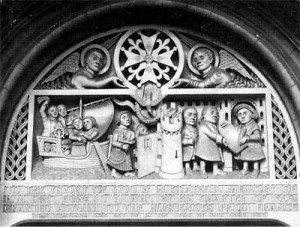By Helen King
In my last post for Wonders & Marvels, I introduced you to my favourite historical  character, the ‘Popish midwife’ Elizabeth Cellier. When I was researching her for the first time some years back, I came across another midwife who was in London at precisely the same time: Mary Awbry, or Hobry. Like Elizabeth, Mary was accused of a crime, and appeared before the Old Bailey. Unlike Elizabeth, Mary came to a sticky end; her story is recounted in a pamphlet entitled ‘A Hellish Murder Committed by a French Midwife, on the Body of Her Husband, Jan. 27, 1687/8 for which she was Arraigned at the Old-Baily, Feb. 22, 1687/8, and Pleaded Guilty, and the Day Following Received Sentence to be Burnt’.
character, the ‘Popish midwife’ Elizabeth Cellier. When I was researching her for the first time some years back, I came across another midwife who was in London at precisely the same time: Mary Awbry, or Hobry. Like Elizabeth, Mary was accused of a crime, and appeared before the Old Bailey. Unlike Elizabeth, Mary came to a sticky end; her story is recounted in a pamphlet entitled ‘A Hellish Murder Committed by a French Midwife, on the Body of Her Husband, Jan. 27, 1687/8 for which she was Arraigned at the Old-Baily, Feb. 22, 1687/8, and Pleaded Guilty, and the Day Following Received Sentence to be Burnt’.
‘Burnt’? Yes, Mary died for her crime. It wasn’t ‘just’ murder: it was the murder of her husband Denis. And it wasn’t just that, either; she dismembered him and hid pieces in various locations around London. And it wasn’t just dismemberment; she used her young son to help conceal the bits. The image of a midwife as murderer was a potent one. This was, indeed, a ‘hellish’ crime.
It is clear from Mary’s evidence to the court that she had been the victim of domestic violence from her impecunious husband one time too many. On the night of the crime Denis returned home drunk, and raped her. But she could not claim this was a crime of passion because she waited until he was asleep before strangling him. It also didn’t help her case that, before the fateful night, she had been heard by witnesses to say ‘I must kill him’.
As she was French – apparently one of many Huguenot immigrants to London at this time – what she said was in fact ‘Il faut que je le tue’. Mary had married Denis Awbry, a Catholic, only four years before she killed him, and her previous name comes up in passing in the account of her trial: Desermeau. This means that her son John, her accomplice, must have been from an earlier relationship.
We know of a midwife called Mary Des Ormeaux from another source, the 1680 licensing records of the Anglican church, in which she provided testimonials from five witnesses and was licensed to serve the French community in London. At this point her husband was a jeweller called Daniel. After I first read about Mary Awbry, I came across Mary Des Ormeaux in the 1991 PhD thesis of Doreen Evenden. There, Mary featured as a model midwife, so I contacted Doreen to let her know my suspicions. Doreen and I spent an afternoon in the British Library reading the account of Mary’s trial together. Doreen was so horrified at what had happened to ‘her’ Mary that she cried out, and a librarian had to come over to threaten us with expulsion! Doreen was persuaded, but neither of us could find any more evidence to tell us how the Huguenot Mary Des Ormeaux ended up with the Catholic Denis Awbry who treated her so badly that she killed him.
Motto 1: maybe two characters you’ve come across in history are the same person: women change their names, and we need to be alert and look out for the connections.
Motto 2: it can all end in tears – and flames.
– the image shows a modern representation of the Huguenots’ flight to England, from the French Protestant church in Soho Square, London –
Further reading:
Doreen Evenden, The Midwives of Seventeenth-Century London (Cambridge University Press, 2000)
Frances Dolan, Marriage and Violence: The Early Modern Legacy (Pennsylania University Press, 2008)
